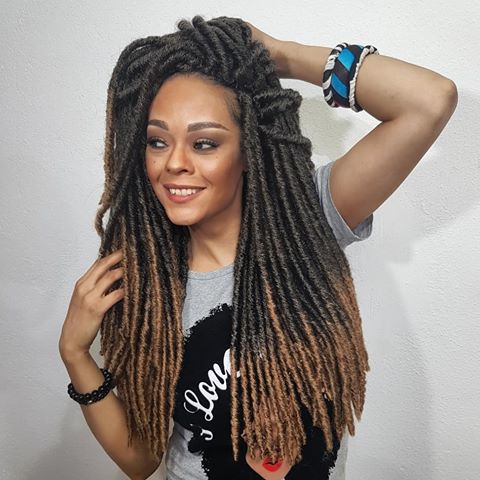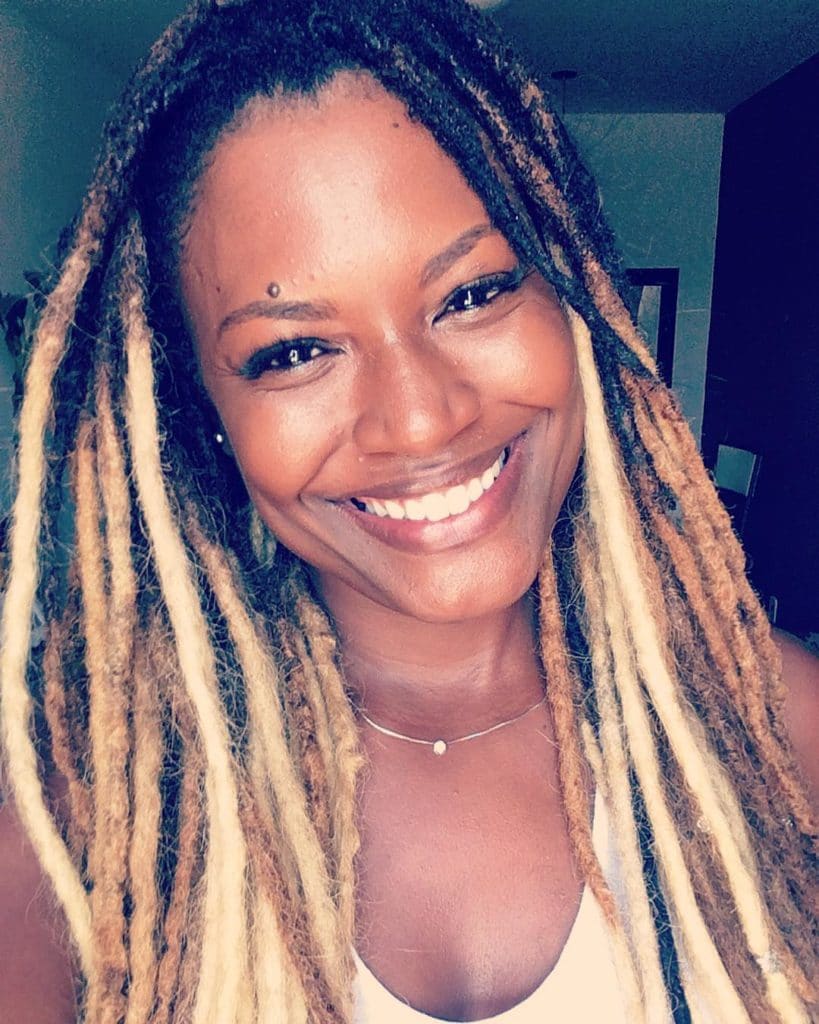Dread is more than just a hairstyle or hairdo.
In the 60s and 70s, the dread gained notoriety through the growing Rastafari movement in Jamaica, and also with Bob Marley, a world reggae icon, who invaded the world with positive messages and his dreadlocks.
But the dreads are much older than that, and they have vast significance in many cultures around the world, even the oldest!
To learn more about dreads, models, styles and inspirations, keep reading this post!

Dread
Dread hair is synonymous with style, attitude and authenticity.
Nowadays, many people have adhered to the style, including colors and other textures, but in the past dread was seen only as a sign of religious vow, where he who adhered to the hair should give up some attitudes, seen as normal within the social coexistence, but of extreme importance in the religious sphere, thus dedicating himself more to spiritual questions and to the elevation of being and nature.
The dread also indicated a greater spiritual connection and purification of body and soul. And that is one of the reasons for finding hair with dreadlocks in various cultures of the ancient world.

In the black movement, since the post-slavery era, dread was used and seen as a sign of struggle, strength and pride, including more meanings, concepts and qualities to the hair.
In recent years, the dread has gained notoriety, due to supporters of the Rastafari movement, who use this hair as a sign of culture and resistance, as well as devotion and religious beliefs.
Bob Marley, one of the greatest reggae artists in the world, adhered to the dreads, and also to the concepts and beliefs of the Rastafari movement, including in his lyrics messages of protest, struggle, positivity, hope, collectivity and love for others.
Also transmitting this essence and meaning to the dreadlocks, which made many people search for this type of hair.
And to this day the dreads demonstrate these characteristics, empowering the look and showing an authentic and strong personality.

Types of dreads
Nowadays, the use of dreads is more related to fashion and beauty subjects, allowing several looks and modern compositions often used by famous and fashionistas.

And with that, they have gained more style and sophistication, but there are still controversial ideas about the dreads, their hygiene and care, but they can be beautiful and strong, like any hair.
The dread, which used to be made only of the yarn itself, has recently gained new application possibilities, such as wool, synthetic hair and among other methods, which can help in a temporary or permanent transformation.
Wool Dreads
Wool dreads are temporary and can be made in all hair types, lengths and in various colors.
It is made from locks that are braided and intertwined with the wool strands, which then involve the hair strands, allowing a tubular effect, equal to the dread made only with hair, but with a different texture and finish.
This method is also less harmful to the hair, making it possible to remove and treat the strands when necessary.

The variety of colors and combinations, is also another positive feature of wool dreads, for those who like constant changes.
It is possible to use colors different from the natural hair, such as gray, purple, blue, and other blends, perfect for fun periods such as spring and summer, and special occasions,
The wool areas, have an average duration of 3 months in the hair, thus needing exchange and maintenance of the wires after the stipulated period.
Synthetic dread
Synthetic dreads are very similar to wool, and are also great options for temporary changes, as they are easier to remove.

They are intertwined with natural hair and then this braid is wrapped around the synthetic threads, forming a thicker, more tubular dread.
Similar to wool dread, with synthetic hair it is possible to make various colors and combinations such as degrade and shoulder hair, leaving the perfect look for various occasions and looks.
The average durability is also 3 months, due to root growth and dread finish.
Dread with needle
Needle dreads are the most common because they are natural and definitive.

They are made with a crochet needle, which has the function of tying the threads of the wick, leaving them together, until they form a tubular or cylindrical dread.
They should be done with hair that has at least the approximate length of 5 fingers, allowing a better effect and ease at the time of execution.
Maintenance is also essential for the health and beauty of the dreads, so look for a professional who does the technique periodically leaving your hair beautiful and full of attitude.
If you are going to do the maintenance yourself, remember to use a crochet needle, with the appropriate thickness, besides washing regularly.
Dread with wax
The dreads with beeswax, recently are little used because they damage the cleanliness and sanitization of the hair.
It is made from a wick, which is shredded with a fine comb and then covered with wax, being twisted and embarrassed until the dread is shaped.

How to dread?
To make the dreads, first it is important to remember that this will be a tremendous transformation, but it will leave you beautiful and empowered.
And the care, is not the same as with normal hair, so it is important to pay attention to our tips and also treat properly, so that they grow strong and healthy.
And to learn more about how to make the dreads, we’ve separated some videos, which will teach and help you create your own dreadlocks.
DIY – Wool Dreads – Tutorial [Vídeo]
Wool dreads are more practical and allow more transient results.
To learn how to do it alone, we separate the video of Aline Amaro, who teaches step by step, to do dreads with wool, thread or string.
DIY – Synthetic Dreads – Tutorial [Vídeo]
Synthetic dreads are very similar to wool dreads, including execution, and it is necessary to interweave them with natural yarns.
To learn more, watch the video of Jacy July, which teaches you how to do it in a practical and fast way.
DIY – Dread with crochet needle – Tutorial – [Vídeo]
Dreads with natural hair and crochet needle are a bit more difficult and laborious to make, but it is possible to make them with a little practice.
In order to interweave the threads well, it is important to use a needle with a very fine tip of approximately 0.5 mm.
To learn more, watch the Do It You video, and learn a little bit, how to handle the crochet needle to do the natural dread.
Combed with dread
If you’re not sure how to do the dreadlocks, for fear of getting sick with loose and stripped down hair styling, know that with the dreads you can create easy hairstyles with a lot of attitude, which will leave your look even more impactful and powerful.
When choosing dreads, know that you will attract more attention, so don’t be surprised by surprised looks!
With this, take the opportunity to abuse accessories such as banners and turbans, in addition to clothes that value you and allow even more authenticity.
Inspirations
The dreads are very democratic, combined with various profiles of men and women.
And regardless of gender, dread inspires a lot of attitude and authenticity, allowing for a unique and sophisticated style.
So, if you identify with the concept and the hair, try the dreadlocks and go through a radical transformation in the look.
See some photos to inspire your dreads.

Women’s Dread
Dreads in women allow an authentic and strong style, which draws attention to where it passes.
However, the fear of damaging the hair is one of the primary factors when deciding whether or not to adhere to dreadlocks.
With this, know that the dread with the needle, can damage the hair, leaving the thread brittle and weaker, if you can remove, so if you are not sure, opt for models of wool or synthetic, which are removable and can be removed by not liking or sickening the strands.
Male Dread
Dreadlocks in men allow a look very stylish and detached.
Nowadays, the hairstyle has gained versions like undercut and Mohican, without losing its authenticity and revolutionary touch.
Short Dreads
If your threads are short and you are thinking about making the dreadlocks, but you are unsure about the effect and result of the size of the threads, here are some photos that will help you decide and for sure, in favor of the dreads.
Besides being very stylish, the dreads on the short hair form a cute but very strong and authentic look.
As mentioned before, to make the dreads it is important to have at least 4 fingers long, but in short dreads it is also possible to make elongations that help in the bulky and detached effect.
This stretching can be done with pre-ready dreads of real or synthetic hair, which are interwoven into the natural ones.

Fine Dreads
The thickness of the dreads can also vary, creating different and elegant styles.
The thin dread is very beautiful, because it allows more movement and lightness in the look, and is ideal for all hair lengths and textures.
Dread jumbo
This thicker dread model gives more volume and height to the hair.
Because it is thicker, it may look heavy, yet they are synonymous with strength and personality.
Care of the dreads
Hygiene and care of the dreads are essential for them to have durability, beauty and strength for growth.
However, maintenance should be done very carefully so as not to break or break the wick, so try to wash at least 3 times a week.
When washing, always use transparent shampoo, anti-residue, anti-dandruff, coconut soap or neutral, helping to keep the dread structured for longer.
It is important that the products of the wash do not contain moisturizing ingredients, such as vegetable oils, which soften the yarn, undoing the tangled and interlaced hair.
The conditioner and mask can also be dispensed with, since hydration in the threads will make it difficult to interlace and tubular effect, which can result in loose dreads and breakage more easily.
When shampooing, it is important to handle the wicks very gently, avoiding rubbing the length and root.
With this, the best way to do the washing is to create a foam to pass in each dread.
Squeeze lightly in order to make the soap penetrate the wire and then rinse with running water until you remove any remaining product.
After washing it is very important to dry the hair well, but do not rub the towel on the hair, do it with the help of a dryer at cold temperature or naturally, in the wind or sun.
Moisture is a major aggravating factor in the healthy maintenance of dreadlocks, so remember that after each wash, drying is essential.
The maintenance of the root should also be done regularly, so repeat the process of dread when you notice the growth of the hair or every 4 months, allowing a well done and beautiful finish to the hair.

How do I get the needle dread off?
Most of the time to remove the dreads made with a crochet needle will require a low cut, which will cause the threads to grow normally again.
However, in some hair textures it is possible to remove combs and moisturizing creams with great patience.

Don’t be afraid to dare. Do the dreads and be yourself!
Leave us your comment and tell us what you think of our post about dread!



